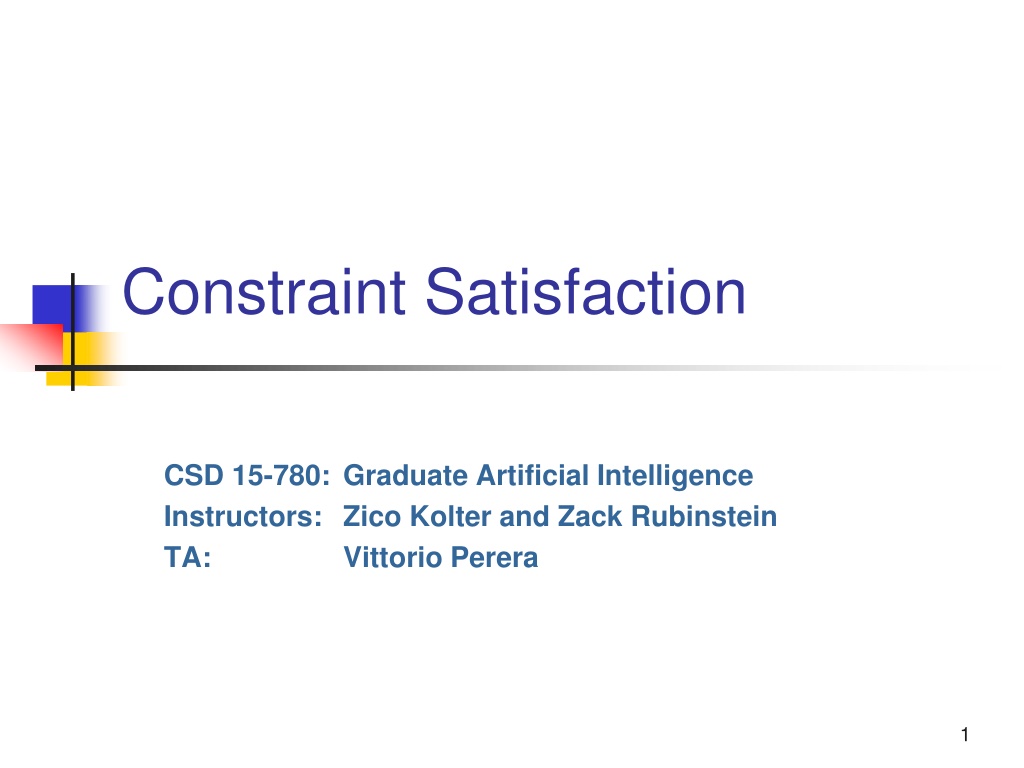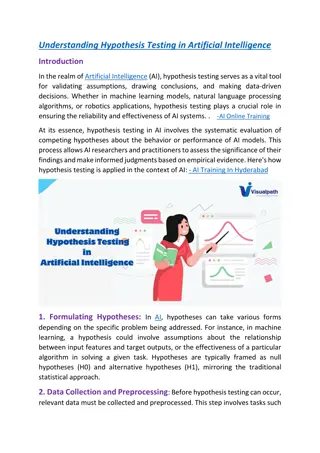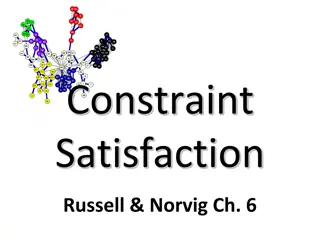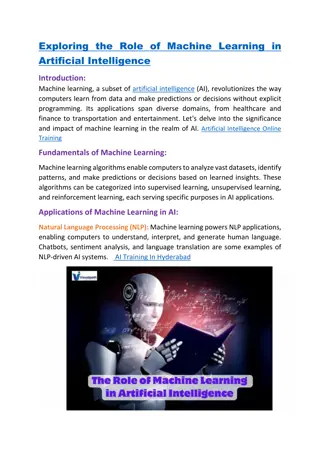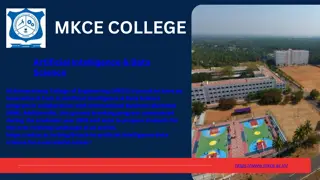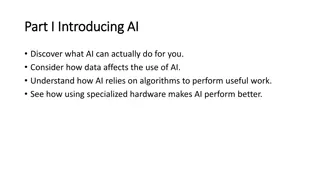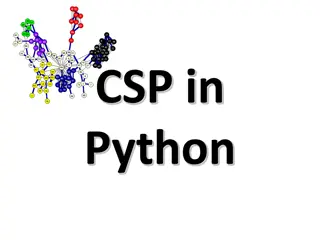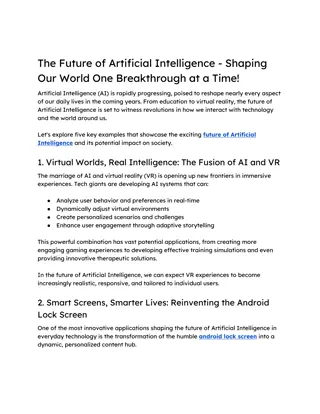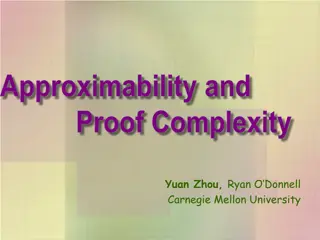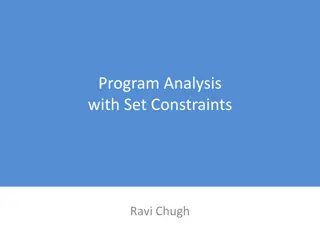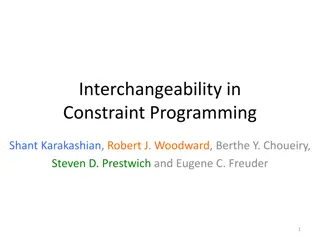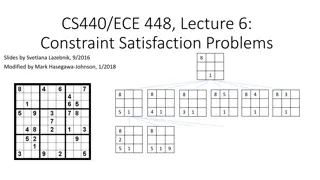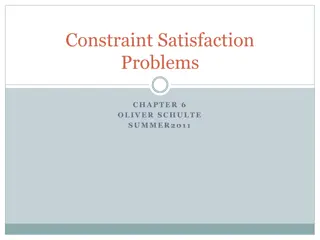Understanding Constraint Satisfaction in Artificial Intelligence
Explore the concept of constraint satisfaction in artificial intelligence, covering topics such as CSPs, finite vs. infinite domains, solving CSPs using search, high-order constraints, constraint optimization, and more. Learn about techniques, examples, and challenges in applying constraints to problem-solving in AI.
Download Presentation

Please find below an Image/Link to download the presentation.
The content on the website is provided AS IS for your information and personal use only. It may not be sold, licensed, or shared on other websites without obtaining consent from the author. Download presentation by click this link. If you encounter any issues during the download, it is possible that the publisher has removed the file from their server.
E N D
Presentation Transcript
Constraint Satisfaction CSD 15-780: Graduate Artificial Intelligence Instructors: Zico Kolter and Zack Rubinstein TA: Vittorio Perera 1
Constraint satisfaction problems A constraint satisfaction problem (CSP): A set of variablesX1 Xn, and a set of constraintsC1 Cm. Each variable Xi has a domainDi of possible values. A solution to a CSP: a complete assignment to all variables that satisfies all the constraints. Representation of constraints as predicates. Visualizing a CSP as a constraint graph. 2
Example: Map coloring NT Q WA SA NSW V T 3
Finite vs. infinite domains Finite domains: 8-queens, matching, cryptarithmetic, job assignment Infinite domains: job scheduling Cannot enumerate all possibilities Need a constraint language: StartJob1+ 5 StartJob3 4
Solving CSPs using search Initial state: the empty assignment Successor function: a value can be assigned to any variable as long as no constraint is violated. Goal test: the current assignment is complete. Path cost: a constant cost for every step. 5
High-order constraints TWO F T U W R O +TWO FOUR O+O = R+10 X1 X1+W+W = U+10 X2 X2+T+T = O+10 X3 X3 = F alldiff(F,T,U,W,R,O) X3 X2 X1 6
Constraint optimization Representing preferences versus absolute constraints. Constraint optimization is generally more complicated. Can be solved using local search techniques. Hard to find optimal solutions. 7
Commutativity Na ve application of search to CSPs: Branching factor is n d at the top level, then (n-1)d, and so on for n levels. The tree has n! dn leaves, even though there are only dn possible complete assignments! Na ve formulation ignores commutativity of all CSPs. Solution: consider a single variable at each depth of the tree. 8
Heuristics that can help Key questions: Which variable should be assigned next and in what order should the values be tried? What are the implications of the current variable assignments for the other unassigned variables? When a path fails, can the search avoid repeating this failure in subsequent paths? 1. 2. 3. 11
Variable and value ordering Variable ordering The most-constrained-variable heuristic fewest legal values) The most-constraining-variable heuristic (involved in largest number of constraints) Value ordering The least-constraining-value heuristic the fewest choices for neighboring vars) (has the (rules out 12
Constraint propagation Reduce the branching factor by deleting values that are not consistent with the values of the assigned variables. Forward checking: a simple kind of propagation 13
Arc consistency An arc from X to Y in the constraint graph is consistent if, for every value of X, there is some value of Y that is consistent with X. Can detect more inconsistencies than forward checking. Can be applied as a preprocessing step before search or as a propagation step after each assignment during search. Process must be applied repeatedly until no more inconsistencies remain. Why? 14
Complexity of arc consistency A binary CSP has at most O(n2) arcs Each arc (X Y) can only be inserted on the agenda d times because at most d values of Y can be deleted. Checking consistency of an arc can be done in O(d2) time. Worst case time complexity is: O(n2d3). 16
K-consistency A graph is k-consistent if, for any set of k variables, there is always a consistent value for the kth variable given any consistent partial assignment for the other k-1 variables. A graph is strongly k-consistent if it is i-consistent for i = 1..k. Higher forms of consistency offer stronger forms of constraint propagation. Specialized algorithms for resource constraints, bounds constraints, etc. 17
Intelligent backtracking Chronological backtracking: always backtrack to most recent assignment. Not efficient! Conflict set: A set of variables that caused the failure. Backjumping: backtrack to the most recent variable assignment in the conflict set. Simple modification of BACKTRACKING-SEARCH. Every branch pruned by backjumping is also pruned by forward checking! Conflict-directed backjumping: better definition of conflict sets leads to better performance. 18
Local search for CSPs Start state is some assignment of values to variables that may violate some constraints. Successor state: change value of one variable. Use heuristic repair methods to reduce the number of conflicts (iterative improvement). The min-conflicts heuristic: choose a value for a variable that minimizes the number of remaining conflicts. Can solve the million-queens problem in an average of 50 steps! 19
Example of min-conflicts A two-step solution of an 8-queens problem. The number of remaining conflicts for each new position of the selected queen is shown. Algorithm moves the queen to the min-conflict square, breaking ties randomly. 21
Scheduling Example A process consists of a set of tasks that are constrained into a partial order by temporal precedence constraints. Each task can be accomplished using a set of resources. There may be multiple sets of resources that can satisfy the task. The problem is to schedule the tasks in such a way as to limit the amount of delay caused by the lack of resource availability. 22
Scheduling Example (cont.) Variables: tasks Values: resource assignments General algorithm: Do critical path analysis Choose task to schedule using variable-ordering heuristic. Generate possible reservation assignments This step is needed to account for the domain being so large (not quite continuous but close). Select reservation assignment using value-ordering heuristic 23
Scheduling Example (cont.) In general, different heuristics result in different schedules. Still, cannot not guarantee quality in schedule. It depends on the individual problem. Not all solutions are possible what do you do? Backtrack Relax termination condition by allowing delay to be introduced. 24
Blackboard Systems Based on a brainstorming experts analogy Experts work as a team to brainstorm a solution to a problem, using a large blackboard as the workplace for cooperatively developing the solution Problem specifications are written onto the blackboard Experts all watch the blackboard, contributing their expertise (on the blackboard) when possible
AI Systems Using BB Hearsay II and III Speech understanding HASP Interpretation of sonar signals AGE Generalized HASP architecture OPM Opportunistic Planner BB1- Generalized OPM GBBOpen BB Framework 26
Blackboard Applications Some blackboard and blackboard-like systems include GEST (Georgia Tech Research Institute) really a hierarchical rule-based shell HCVM (FMC & Cimflex Teknowledge) BB1-like architecture with control-flow short cuts to avoid some of BB1 s overhead RT-1 (FMC) another BB1-like architecture with short cuts Erasmus (Boeing) a meta-architecture built on top of BBB (Boeing s BB1-like architecture), UMass GBB, or GBB ATOME (CRIN/INRIA-Lorraine, Franc) another BB1-like architecture with control extensions
Blackboard Applications DVMT (UMass, UMass GBB) Vehicle monitoring task used to model issues in DAI Protean (Stanford, BB1) Identify family of solution-borne 3D protein structures from NMR data PBA (FMC/Teknowledge, RT-1) Real-time monitoring and control of phosphorus manufacturing Pilot s Associate (various, UMass GBB, GBB, home- brew) Enhance situational awareness and decision-making support for pilots in advanced fighter aircraft
Early Blackboard Applications CIM EX (Boeing, UMass GBB) Pilot s-associate-like domain with emphasis on smart interface management (PVI) Macro (Rockwell & Stanford, UMass GBB) Control of carbon-carbon-composite pyrolysis SARGE (TI, UMass GBB, GBB) Develop, evaluate, and refine tactical decision aids Guardian (Stanford, BB1) Intensive-care patient monitoring Intelligent Tutor (FMC, BB1) Dynamic planning of instructional-material presentation
Blackboard Applications Address-block recognition (SUNY Buffalo) On-line network maintenance and diagnosis (Framentec, France) Model-based diagnostic reasoning (MIT, Tektronix) Pseike robot-control architecture (Purdue) Weather prediction (Toronto) Telecommunications-network management (Neher Labs, The Netherlands) Human-interface tool suite (MCC)
Blackboard-System Application Areas Sensory interpretation Design and layout Process control Planning and scheduling Computer vision Knowledge-based simulation Command and control Symbolic learning Case-based reasoning Data fusion Knowledge-based instruction
What is a Blackboard System? A simple problem-solving concept Knowledge modules interacting via a shared database Extremely subtle and open- ended in realization Will detail these issues Begin by contrasting with rule- based systems Many similarities both approaches were conceived about the same time both have notion of anonymous invocation E=mc2 `(first ,b) Module A Module B Module C Module D Module E
Rule-Based Systems Characteristics Control implicit in rule ordering Strong dependency between inference engine and knowledge base Unstructured working memory Lots of rules Fine-grained control Most working-memory changes are significant Inference Engine Knowledge Base (Rules) Working Memory
Blackboard Systems Characteristics Explicit flexible control separate from KB Multiple inference engines and KB representations Structured working memory (blackboard) A few knowledge sources Large-grained control Many blackboard changes are not immediately significant WM (internal) Inference Engine Knowledge Base Control Shell Blackboard
Blackboard System Components Knowledge Sources (KSs) software specialists; each providing expertise needed by the application The Blackboard shared repository of problems, partial solutions, suggestions, recommendations, and contributed information Control Shell controls the flow of problem- solving activity in the application Knowledge Sources Sources Sources Sources Knowledge Knowledge Knowledge Control Shell Blackboard
Characteristics of a Blackboard System Large-grained cooperating knowledge source (KS) problem-solving model KSs can use diverse internal problem-solving representations and implementations KSs interact anonymously using shared global database called the blackboard Blackboard serves as communication medium and buffer Blackboard serves as community memory of data, results, and control information Blackboard serves as KS trigger mechanism Opportunistic problem solving directed by explicit control component Separate from individual domain KSs Large-grained control of KS executions
Additional Characteristics No consensus, but often present! Solution is generated incrementally Multiple levels of abstraction Structured blackboard beyond level partitioning Competing hypotheses problem-solving representation Blackboard used for control information Reflexive control implemented using blackboard system Multiple KS representations many classic blackboard systems support only a single KS representation actually partitioned rule-based systems we won t consider them as true blackboard systems
Communicating Modules Data-flow-systems design identify functional modules connect them according to communication paths Advantages simple, predictable organization Disadvantages static processing paths direct interaction (changes in functional modules requires redesign) leads to private interaction protocols that make interoperability difficult
Blackboard Systems Blackboard-systems design identify functional modules, blackboard structure, and objects add control strategies as needed Advantages dynamic processing paths adapt to situation indirect interaction allows transparent reorganization public representation allows other modules, development/monitoring tools, and control components to access communications blackboard serves as repository Disadvantages more complex system infrastructure is needed
Advantages of Blackboard Systems Modularity KSs can be developed independently KSs can have been developed long before the blackboard- system application itself Integration KSs can use widely differing approaches, representations, programming languages KSs can use diverse hardware--locally or remotely Extensibility New KSs can be added easily Existing KSs can be upgraded to new versions
Advantages of Blackboard Systems Reusability KSs that provide expertise to one application can be redeployed in new applications Strategic control Determines where the application expends its resources Important when The number of KSs grows KSs have overlapping capabilities
Why Use a Blackboard System? When multilevel reasoning or flexible, dynamic control is required The original AI focus When heterogeneous problem-solving representations and expertise must be integrated Including integration of legacy applications When many developers are involved Large-grained anonymous modularity is important for design, implementation and maintenance metaprogramming
Development Strategy Overview Initial design Determine blackboard structure Determine blackboard objects and their attributes The interaction ontology for the system Identify KSs Legacy and to be written Sanity check Match KS interactions with blackboard structure and objects Prototyping Prototype new KSs Interface legacy KSs Combine KSs to test interactions
Development Strategy Overview Adding control Develop control knowledge and appropriate control strategies Test the application Perform performance tuning
Hearsay-II: The original BB system Overview Who: Carnegie Mellon University When: 1975-1977 Domain: Connected speech recognition database retrieval Goals: 1000 word vocabulary, speaker trained, silent environment 90% functionally accurate interpretations 1/10th real time with a single processor hoped to use multiprocessing to achieve real-time performance Characteristics: 15 KSs (C1 configuration), 12-13 (C2 configuration)
Hearsay-II: Architectural Requirements Reduce search combinatorics using abstraction Opportunistic application of diverse knowledge Compensate for unreliable sensor data by incremental application of constraints Apply diverse knowledge intelligently, without a known problem-solving algorithm Support multiple system builders via modularization Support system experimentation and evolution based on experience using the system Support high-performance problem solving using procedural knowledge Support parallelism
Hearsay-II: Levels and KSs Database Interface PREDICT STOP SEMANT Phrase WORD-SEQ-CTL CONCAT PARSE Word-sequence WORD-CTL WORD-SEQ VERIFY Word RPOL MOW Syllable POM Segment SEG Parameter time
Hearsay-II: KSs SEG: digitizes the signal POM: synthesizes syllable-class hypotheses MOW: synthesizes word hypotheses WORD-SEQ: synthesizes word-sequence hypotheses PARSE: synthesizes a phrase PREDICT: predicts all possible words before or after a phrase VERIFY: checks the consistency between segments and paired words in a phrase CONCAT: creates a phrase from verified phrase predictions
Hearsay-II: KSs WORD-CTL: controls the behavior of MOW WORD-SEQ-CTL: controls the behavior of WORD-SEQ RPOL: rates the credibility of new or modified hypotheses STOP: decides when to halt processing and attempt an answer SEMANT: generates the answer when STOP gives the go ahead
